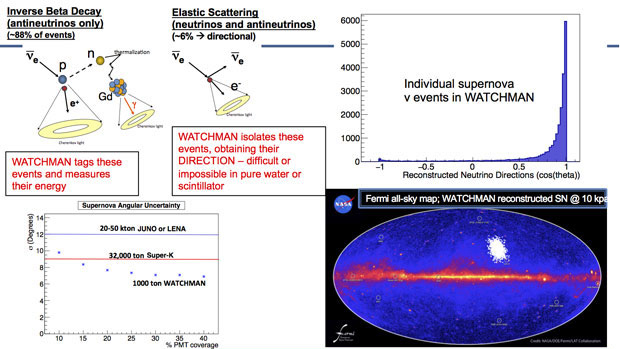Adam Bernstein (15-ERD-021)
Project Description
The water Cherenkov monitor for antineutrinos (WATCHMAN) is a nonproliferation and neutrino science project to deploy a kiloton-scale, gadolinium-doped water Cherenkov detector approximately 15 km from a nuclear reactor in the United States. If deployed, this detector may revolutionize the global nonproliferation regime through remote detection to sharply reduce the risk of nations illicitly operating undeclared reactors for plutonium production. In addition, it has the potential to provide a flexible laboratory to enable a wealth of fundamental neutrino science that has been identified as a high priority by the DOE Office of High Energy Physics. We plan to adapt the detector for such studies of the fundamental properties of neutrinos. Specifically, we will evaluate the capability of WATCHMAN to measure neutrino mass hierarchy by modifying an existing, custom-built WATCHMAN code. The code will be based on the Geant4 simulation tool that models the passage of particles through matter based on Monte Carlo calculations, which rely on repeated random sampling to compute results. The modified code will be used to examine detector response to mass hierarchy effects, taking into account uncertainties in the underlying oscillation and mass-difference parameters that affect measurements, as well as detector-related systematic effects. We will quantify the potential of WATCHMAN for supernova detection (see figure), the search for a fourth neutrino type, the neutrino mass hierarchy, and nonstandard neutrino interactions. This study may also ultimately benefit the design choice for WATCHMAN by identifying a minimum target mass, or energy resolution for which an acceptable level of sensitivity can be demonstrated for remote reactor detection.
We expect to strengthen the scientific case for WATCHMAN by investigating the sensitivity of the baseline and follow-on WATCHMAN designs for measurements of interest for fundamental science. We will employ an existing detailed Geant4-based custom Monte Carlo code to assess WATCHMAN's sensitivity to sterile neutrino oscillations, nonstandard neutrino interactions, and supernova. We will extend and refine the Monte Carlo package to assess sensitivity of upgraded versions of the detector to the neutrino mass hierarchy, Earth-produced antineutrinos, proton decay, and other phenomena. The impact of extending the physics reach on the detector design will also be considered and incorporated into our studies.
Mission Relevance
Our research will simultaneously help reduce the global threat from weapons of mass destruction as well as address scientific issues of importance to the Laboratory, NNSA, and DOE. By demonstrating and extending the scientific potential of WATCHMAN, we support Livermore's strategic core competency investments in nuclear, chemical, and isotopic science and technology.FY16 Accomplishments and Results
In FY16 we (1) evaluated implications for the scientific potential of water Cherenkov antineutrino physics experiments for supernova detection and tests of electroweak theory via the IsoDAR (Isotope Decay-at-Rest) beam experiment; (2) developed a detailed and comprehensive simulation package known as RAT-PAC (the Reactor Analysis Tool Plus Additional Codes) for reactor antineutrino studies in collaboration with the University of California, Berkeley, and University of California, Davis, as well as the University of Hawaii; and (3) performed simulations showing the potential of the water-based liquid scintillator to improve the ability to distinguish high-energy particle types (proton, muons, and other gigaelectronvolt-scale particles) based on the timing, spatial distribution, and relative intensities of the Cherenkov and scintillation light produced by particle interactions in the water-based liquid scintillator.
Publications and Presentations
- Dazeley, S., and A. Bernstein, The WATCHMAN detector. APS April Mtg., Baltimore, MD, Apr.11–14, 2015. LLNL-PRES-669510.
- Dazeley, S., et al., "A search for cosmogenic production of beta-neutron emitting radionuclides in water." Nucl. Instrum. Meth. Phys. Res. A 821, 151 (2016). LLNL-JRNL-677613. http://dx.doi.org/10.1016/j.nima.2016.03.014
- Dazeley, S., et al., Long distance reactor antineutrino flux monitoring. Ann. Fall Mtg. APS Division of Nuclear Physics, Santa Fe, NM, Oct. 28–31, 2015. LLNL-PRES-678683.






